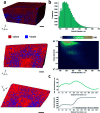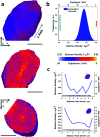Ptychographic X-ray tomography reveals additive zoning in nanocomposite single crystals
- PMID: 32874489
- PMCID: PMC7442293
- DOI: 10.1039/c9sc04670d
Ptychographic X-ray tomography reveals additive zoning in nanocomposite single crystals
Abstract
Single crystals containing nanoparticles represent a unique class of nanocomposites whose properties are defined by both their compositions and the structural organization of the dispersed phase in the crystalline host. Yet, there is still a poor understanding of the relationship between the synthesis conditions and the structures of these materials. Here ptychographic X-ray computed tomography is used to visualize the three-dimensional structures of two nanocomposite crystals - single crystals of calcite occluding diblock copolymer worms and vesicles. This provides unique information about the distribution of the copolymer nano-objects within entire, micron-sized crystals with nanometer spatial resolution and reveals how occlusion is governed by factors including the supersaturation and calcium concentration. Both nanocomposite crystals are seen to exhibit zoning effects that are governed by the solution composition and interactions of the additives with specific steps on the crystal surface. Additionally, the size and shape of the occluded vesicles varies according to their location within the crystal, and therefore the solution composition at the time of occlusion. This work contributes to our understanding of the factors that govern nanoparticle occlusion within crystalline materials, where this will ultimately inform the design of next generation nanocomposite materials with specific structure/property relationships.
This journal is © The Royal Society of Chemistry 2020.
Figures




Similar articles
-
Efficient Occlusion of Nanoparticles within Inorganic Single Crystals.Acc Chem Res. 2020 Jun 16;53(6):1176-1186. doi: 10.1021/acs.accounts.0c00103. Epub 2020 May 18. Acc Chem Res. 2020. PMID: 32421304
-
Spatioselective Occlusion of Copolymer Nanoparticles within Calcite Crystals Generates Organic-Inorganic Hybrid Materials with Controlled Internal Structures.Angew Chem Int Ed Engl. 2024 Oct 21;63(43):e202410908. doi: 10.1002/anie.202410908. Epub 2024 Aug 20. Angew Chem Int Ed Engl. 2024. PMID: 38954489
-
Exerting Spatial Control During Nanoparticle Occlusion within Calcite Crystals.Angew Chem Int Ed Engl. 2020 Oct 5;59(41):17966-17973. doi: 10.1002/anie.202007110. Epub 2020 Aug 13. Angew Chem Int Ed Engl. 2020. PMID: 32613700
-
Polymer-Inorganic Crystalline Nanocomposite Materials via Nanoparticle Occlusion.Macromol Rapid Commun. 2022 Jul;43(14):e2100793. doi: 10.1002/marc.202100793. Epub 2022 Feb 5. Macromol Rapid Commun. 2022. PMID: 35078274 Review.
-
Super-Resolution Microscopy Reveals Shape and Distribution of Dislocations in Single-Crystal Nanocomposites.Angew Chem Int Ed Engl. 2019 Nov 25;58(48):17328-17334. doi: 10.1002/anie.201905293. Epub 2019 Oct 31. Angew Chem Int Ed Engl. 2019. PMID: 31591809 Review.
Cited by
-
Dynamic change of calcium-rich compartments during coccolithophore biomineralization.Sci Adv. 2025 Jul 25;11(30):eadv0618. doi: 10.1126/sciadv.adv0618. Epub 2025 Jul 23. Sci Adv. 2025. PMID: 40700501 Free PMC article.
-
An efficient ptychography reconstruction strategy through fine-tuning of large pre-trained deep learning model.iScience. 2023 Nov 10;26(12):108420. doi: 10.1016/j.isci.2023.108420. eCollection 2023 Dec 15. iScience. 2023. PMID: 38034346 Free PMC article.
-
Evolution of Hierarchically Porous Nickel Alumina Catalysts Studied by X-Ray Ptychography.Adv Sci (Weinh). 2022 Mar;9(8):e2105432. doi: 10.1002/advs.202105432. Epub 2022 Jan 20. Adv Sci (Weinh). 2022. PMID: 35289133 Free PMC article.
-
Mechanical adaptation of brachiopod shells via hydration-induced structural changes.Nat Commun. 2021 Sep 10;12(1):5383. doi: 10.1038/s41467-021-25613-4. Nat Commun. 2021. PMID: 34508091 Free PMC article.
References
-
- Zhang S. J., Pelligra C. I., Feng X. D., Osuji C. O. Adv. Mater. 2018;30(18):23. - PubMed
-
- Hao Y. N., Wang X. H., Bi K., Zhang J. M., Huang Y. H., Wu L. W., Zhao P. Y., Xu K., Lei M., Li L. T. Nano Energy. 2017;31:49–56.
-
- Chen A. P., Su Q., Han H., Enriquez E., Jia Q. X. Adv. Mater. 2019;31(4):1803241. - PubMed
-
- Ning Z., Gong X., Comin R., Walters G., Fan F., Voznyy O., Yassitepe E., Buin A., Hoogland S., Sargent E. H. Nature. 2015;523:324–328. - PubMed
LinkOut - more resources
Full Text Sources

